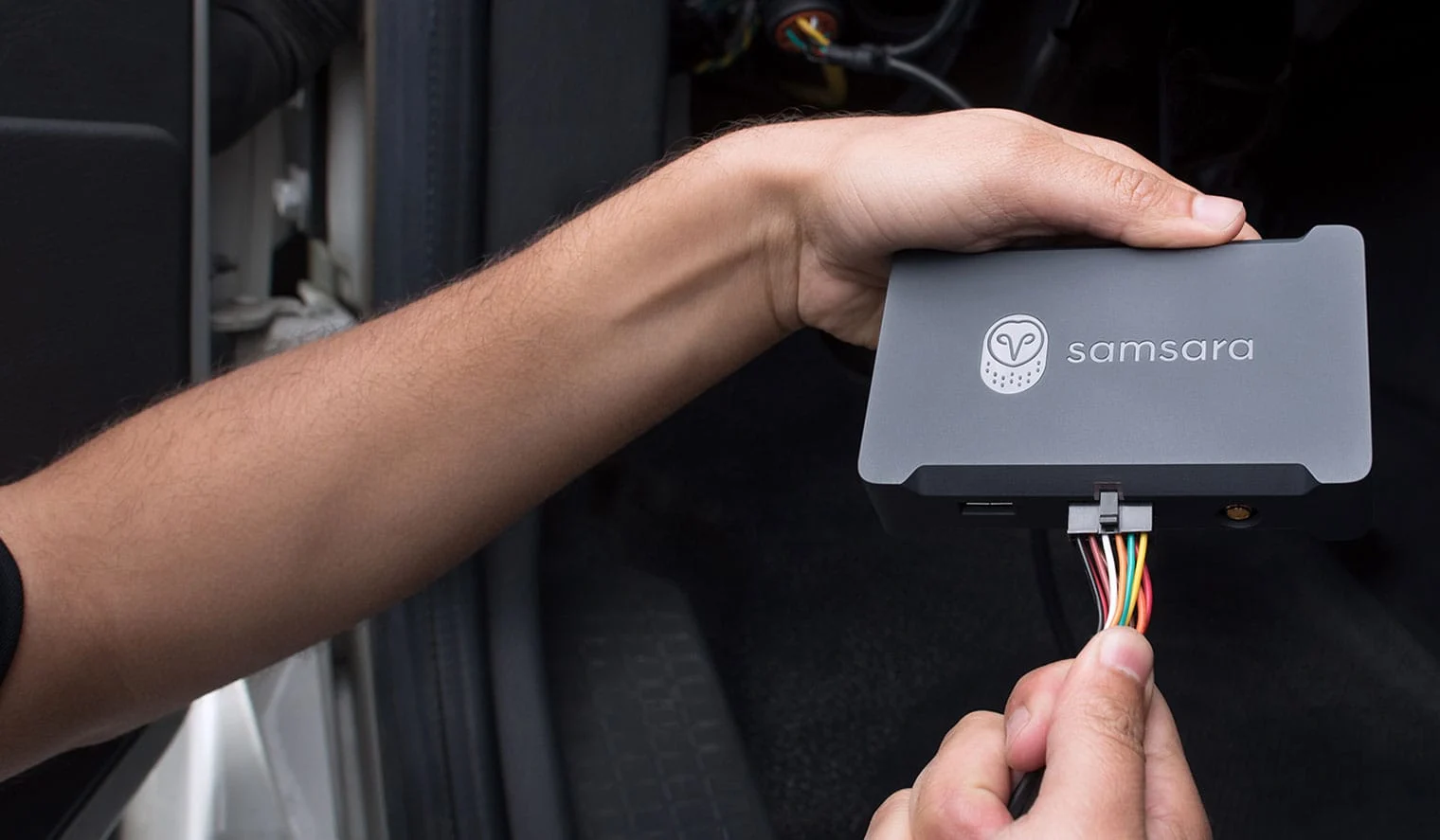Efficiency, Safety
4 ways technology is transforming Canadian oil and gas operations
May 28, 2025
Director, Strategic Markets Product Management

Get the latest from Samsara
Subscribe nowThe Canadian oil and gas sector has always operated in high-stakes environments—but today’s market dynamics are prompting a fundamental shift. Volatile commodity prices, rising labour costs, surging insurance premiums, and increasingly remote work sites are putting growing pressure on upstream, midstream, and downstream operations to do more—with less.
In this environment, safety, compliance, and equipment uptime are essential to protecting margins and meeting deadlines. To stay competitive, energy leaders are embracing connected technologies that enhance visibility, from the wellhead to the control room.
By digitizing workflows, streamlining dispatch, and using real-time data across fleets and field assets, they’re cutting costs, protecting crews, and keeping jobs on schedule.
Here are four ways technology is helping Canadian oil and gas operators work smarter, even in the most remote and rugged conditions.
1. Cutting costs—without cutting corners
With oil and gas operating expenses climbing across the sector—especially in Alberta, where labour costs and insurance premiums are among the highest—controlling costs has become critical. Add in the volatility of oil prices, and planning becomes even more complex.
That’s why future-focused operators are leveraging technology to boost efficiency and protect margins. From curbing unnecessary trips and fuel waste to extending asset life, here’s how smart tools and integrations are making a measurable impact:
Fuel and idling reports identify inefficiencies like excessive engine idling or unnecessary trips, allowing teams to adjust behaviour and lower fuel costs.
Driver efficiency scorecards monitor habits like speeding, harsh braking, and prolonged idling, enabling targeted coaching that improves safety and reduces wear-and-tear.
Preventive maintenance tools and programs leverage diagnostic data to catch issues before breakdowns occur—minimizing unplanned downtime and extending asset lifespan.
Fuel management integrations provide real-time visibility into consumption and spending, streamlining oversight and budgeting.
Together, these tools support more efficient operations with lower total cost of ownership—all without compromising reliability or safety.
2. Preventing incidents and protecting crews in real time
In the oil and gas industry, safety is a constant challenge. Crews often work long shifts in harsh environments, from icy winter roads to remote job sites hours from the nearest emergency service. Fatigue, unpredictable weather, and geographic isolation all increase the risk of incidents on and off the road.
To mitigate these challenges, operators are adopting real-time safety technologies that enable faster response and greater oversight:
AI-powered dash cams detect signs of drowsiness—such as head nodding, face rubbing, yawning, and prolonged idling—giving supervisors the ability to intervene early and prevent fatigue-related incidents.
Satellite connectivity and in-cab panic buttons ensure crews can call for help instantly, even when operating far beyond cellular coverage.
Real-time weather overlays help dispatchers and drivers anticipate environmental risks and make informed routing decisions in changing conditions.
By combining proactive safety insights with tools for immediate communication, operators are better equipped to prevent incidents and respond quickly, no matter how remote the location.
3. Streamlining mapping and dispatch—all in one system
Regulatory compliance in oil and gas is non-negotiable—but it doesn’t have to be time-consuming. In Alberta, the Alberta Energy Regulator (AER) requires the use of Legal Subdivision (LSD) mapping for permits, site documentation, and reporting. But most commercial platforms aren’t built to handle LSD coordinates, forcing teams to rely on manual workarounds that increase administrative burden, and the risk of errors.
That’s why integrated solutions with built-in LSD mapping are critical. With LSD mapping capabilities, oil and gas operators can:
Quickly locate sites across Alberta, Saskatchewan, and Manitoba using LSD map overlays, eliminating guesswork and reducing navigation errors.
Streamline dispatch workflows by assigning crews based on accurate location data and real-time asset visibility.
With LSD mapping directly embedded in platforms like Samsara’s, frontline teams and back-office staff stay aligned, ensuring that regulatory documentation is always accurate, consistent, and audit-ready.
Caption: Visualization of Legal Subdivision (LSD) mapping in Canada, highlighting grid overlays across the Prairie provinces.

4. Improving visibility and keeping jobs on track
For many oil and gas operators, efficiency hinges on knowing exactly where your people and assets are at any given time. But when crews are deployed across vast, remote regions, visibility becomes a challenge. Labour shortages only add to the pressure—especially during seasonal surges when skilled operators are in short supply.
To stay agile, many operators are turning to connected technologies that provide real-time visibility needed to respond quickly and allocate resources effectively. Key capabilities that support this level of operational awareness include:
Live GPS tracking to monitor the exact location of vehicles and equipment in real time.
Satellite-connected dashboards that maintain visibility—even in off-grid or low-connectivity areas.
Automated asset tracking to quickly locate and redeploy equipment—big or small—on demand.
Integrated dispatching tools to reassign crews and resources based on real-time conditions.
With these systems in place, operators can reduce downtime, improve utilization, and stay agile, ensuring that jobs keep moving, even when conditions shift.
The future of Canadian oil and gas is connected
Across Canada’s oil and gas sector, digital transformation has shifted from a long-term goal to an operational necessity. Leading companies are setting the pace by adopting real-time insights, connected workflows, and scalable tools designed to meet the industry’s unique challenges—from remote environments to complex compliance needs.
Liberty Energy
At Liberty Energy, a North American oilfield services firm with offices in Calgary and Red Deer, AB, centralized visibility is streamlining operations. “When we can see everything in one place, our entire operation comes together,” said Michael Tuomi, Health & Safety Manager. “With Samsara, we could fully integrate our payroll systems, maintenance software, tax structure, and monitor our third-party drivers, all in a simple, easy-to-use platform.”
That visibility is also driving significant financial impact. Real-time GPS tracking and a custom integration with their tax service provider have enabled Liberty to accurately report on equipment use—resulting in over CA$13 million in expected annual savings.
With Samsara AI Dash Cams, Liberty has reduced vehicle accidents by 50%, saving over CA$680,000 in related costs. Fuel reports have helped lower usage by 25%, while streamlined workflows save the team more than 10,000 hours and CA$350,000 per year.
Certarus
For Certarus, a leader in low-carbon energy solutions across Canada and the United States, digital tools are enabling smarter, more efficient operations. “We’re unlocking our people’s talents by eliminating manual processes,” said Chi Fang, Director of Technology & Business Process. “Now, they have the time and clarity to focus on higher-value work that drives bigger business impact.”
By integrating Samsara with their existing systems, Certarus saved over CA$685,000 in maintenance costs in one year. They now auto-generate 95% of invoices, saving more than 8,500 hours annually, and have secured over CA$137 million in new contracts using Samsara's data across their assets.
From the oil sands of Alberta to the basins of B.C. and Saskatchewan, Canadian energy leaders are proving that no environment is too remote—and no operation too complex—when powered by the right technology.
Ready to explore how your fleet can maximize operational visibility, safety, and efficiency in Canada’s oil and gas sector? Schedule a demo to see how connected operations can drive real impact—or log in to unlock more value from your existing Samsara platform.
Request a demoGet the latest from Samsara
Subscribe now
















